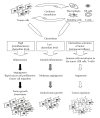Role of chemokine network in the development and progression of ovarian cancer: a potential novel pharmacological target
- PMID: 20049170
- PMCID: PMC2798669
- DOI: 10.1155/2010/426956
Role of chemokine network in the development and progression of ovarian cancer: a potential novel pharmacological target
Abstract
Ovarian cancer is the most common type of gynecologic malignancy. Despite advances in surgery and chemotherapy, the survival rate is still low since most ovarian cancers relapse and become drug-resistant. Chemokines are small chemoattractant peptides mainly involved in the immune responses. More recently, chemokines were also demonstrated to regulate extra-immunological functions. It was shown that the chemokine network plays crucial functions in the tumorigenesis in several tissues. In particular the imbalanced or aberrant expression of CXCL12 and its receptor CXCR4 strongly affects cancer cell proliferation, recruitment of immunosuppressive cells, neovascularization, and metastasization. In the last years, several molecules able to target CXCR4 or CXCL12 have been developed to interfere with tumor growth, including pharmacological inhibitors, antagonists, and specific antibodies. This chemokine ligand/receptor pair was also proposed to represent an innovative therapeutic target for the treatment of ovarian cancer. Thus, a thorough understanding of ovarian cancer biology, and how chemokines may control these different biological activities might lead to the development of more effective therapies. This paper will focus on the current biology of CXCL12/CXCR4 axis in the context of understanding their potential role in ovarian cancer development.
Figures



Similar articles
-
Biological/pathological functions of the CXCL12/CXCR4/CXCR7 axes in the pathogenesis of bladder cancer.Int J Clin Oncol. 2017 Dec;22(6):991-1000. doi: 10.1007/s10147-017-1187-x. Epub 2017 Oct 11. Int J Clin Oncol. 2017. PMID: 29022185 Review.
-
Multiple actions of the chemokine CXCL12 on epithelial tumor cells in human ovarian cancer.Cancer Res. 2002 Oct 15;62(20):5930-8. Cancer Res. 2002. PMID: 12384559
-
CXCL12/CXCR4 signal transduction in diseases and its molecular approaches in targeted-therapy.Immunol Lett. 2020 Jan;217:91-115. doi: 10.1016/j.imlet.2019.11.007. Epub 2019 Nov 17. Immunol Lett. 2020. PMID: 31747563 Review.
-
CXCL12/CXCR4 signaling in malignant brain tumors: a potential pharmacological therapeutic target.Brain Tumor Pathol. 2011 Apr;28(2):89-97. doi: 10.1007/s10014-010-0013-1. Epub 2011 Jan 6. Brain Tumor Pathol. 2011. PMID: 21210239 Review.
-
Role of CXCL12-CXCR4 axis in ovarian cancer metastasis and CXCL12-CXCR4 blockade with AMD3100 suppresses tumor cell migration and invasion in vitro.J Cell Physiol. 2019 Apr;234(4):3897-3909. doi: 10.1002/jcp.27163. Epub 2018 Sep 7. J Cell Physiol. 2019. Retraction in: J Cell Physiol. 2022 Mar;237(3):2005. doi: 10.1002/jcp.30517. PMID: 30191987 Retracted.
Cited by
-
Cytokines, chemokines, and chemokine receptors quantitative expressions in patients with ovarian cancer.Iran J Med Sci. 2015 May;40(3):225-32. Iran J Med Sci. 2015. PMID: 25999622 Free PMC article.
-
Intraoperative imaging in ovarian cancer: fact or fiction?Mol Imaging. 2011 Aug;10(4):248-57. doi: 10.2310/7290.2011.00004. Epub 2011 Apr 26. Mol Imaging. 2011. PMID: 21521557 Free PMC article. Review.
-
Chemokine Network and Overall Survival in TP53 Wild-Type and Mutant Ovarian Cancer.Immune Netw. 2018 Aug 13;18(4):e29. doi: 10.4110/in.2018.18.e29. eCollection 2018 Aug. Immune Netw. 2018. PMID: 30181917 Free PMC article.
-
Soluble Receptor for Advanced Glycation End Products Improves Stromal Cell-Derived Factor-1 Activity in Model Diabetic Environments.Adv Wound Care (New Rochelle). 2016 Dec 1;5(12):527-538. doi: 10.1089/wound.2015.0674. Adv Wound Care (New Rochelle). 2016. PMID: 28078186 Free PMC article.
-
CXCL12/CXCR4: a symbiotic bridge linking cancer cells and their stromal neighbors in oncogenic communication networks.Oncogene. 2016 Feb 18;35(7):816-26. doi: 10.1038/onc.2015.139. Epub 2015 May 11. Oncogene. 2016. PMID: 25961926 Review.
References
-
- Krieg C, Boyman O. The role of chemokines in cancer immune surveillance by the adaptive immune system. Seminars in Cancer Biology. 2009;19(2):76–83. - PubMed
-
- Charo IF, Ransohoff RM. The many roles of chemokines and chemokine receptors in inflammation. The New England Journal of Medicine. 2006;354(6):610–621. - PubMed
-
- Zlotnik A, Yoshie O. Chemokines: a new classification system and their role in immunity. Immunity. 2000;12(2):121–127. - PubMed
-
- Loetscher P, Moser B, Baggiouni M. Chemokines and their receptors in lymphocyte traffic and HIV infection. Advances in Immunology. 2000;(74):127–180. - PubMed
LinkOut - more resources
Full Text Sources

